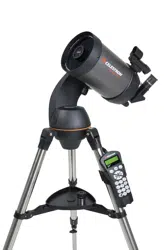Loading ...
Loading ...
Loading ...

14 I ENGLISH
Focal length of Telescope (mm)
Magnification =
_____________________________
Focal length of Eyepiece (mm)
Let’s say, for example, you are using the 25mm eyepiece. To determine the magnification you simply divide the focal length
of your telescope (for example, the NexStar 6SLT has a focal length of 1500mm) by the focal length of the eyepiece,
25mm. Dividing 1500 by 25 yields a magnification of 60 power.
Although the power is variable, each instrument under average skies has a limit to the highest useful magnification.
The general rule is that 60 power can be used for every inch of aperture. For example, the NexStar 6SLT (127mm) in
diameter. Multiplying 6 by 60 gives a maximum useful magnification of 360 power. Although this is the maximum useful
magnification, most observing is done in the range of 20 to 35 power for every inch of aperture which is 120 to 210 times
for the NexStar 6SLT.
CALCULATING MAGNIFICATION
You can change the power of your telescope just by changing the eyepiece (ocular). To determine the magnification of
your telescope, simply divide the focal length of the telescope by the focal length of the eyepiece used. In equation format,
the formula looks like this:
A telescope is an instrument that collects and focuses
light. The nature of the optical design determines how
the light is focused. Some telescopes, known as refractors,
use lenses. Other telescopes, known as reflectors, use
mirrors. The Schmidt-Cassegrain optical system uses
a combination of mirrors and lenses and is referred to
as a compound or catadioptric telescope. This unique
design offers large-diameter optics while maintaining very
short tube lengths, making them extremely portable. The
Schmidt-Cassegrain system consists of a corrector plate,
a spherical primary mirror, and a secondary mirror. Once
light rays enter the optical system, they travel the length of
the optical tube three times.
TELESCOPE BASICS
A cutaway view of the light path of the
Schmidt-Cassegrain optical design
The image orientation of any telescope changes depending on how the eyepiece is inserted into the telescope. When observing
through the using the diagonal, the image will be right side up, but reversed from left to right. When observing straight through,
with the eyepiece inserted directly into the telescope, the image will be inverted.
IMAGE ORIENTATION
Reversed from left to right, as
viewed with a Star Diagonal
Inverted image, as viewed with the
eyepiece directly in telescope
Loading ...
Loading ...
Loading ...
